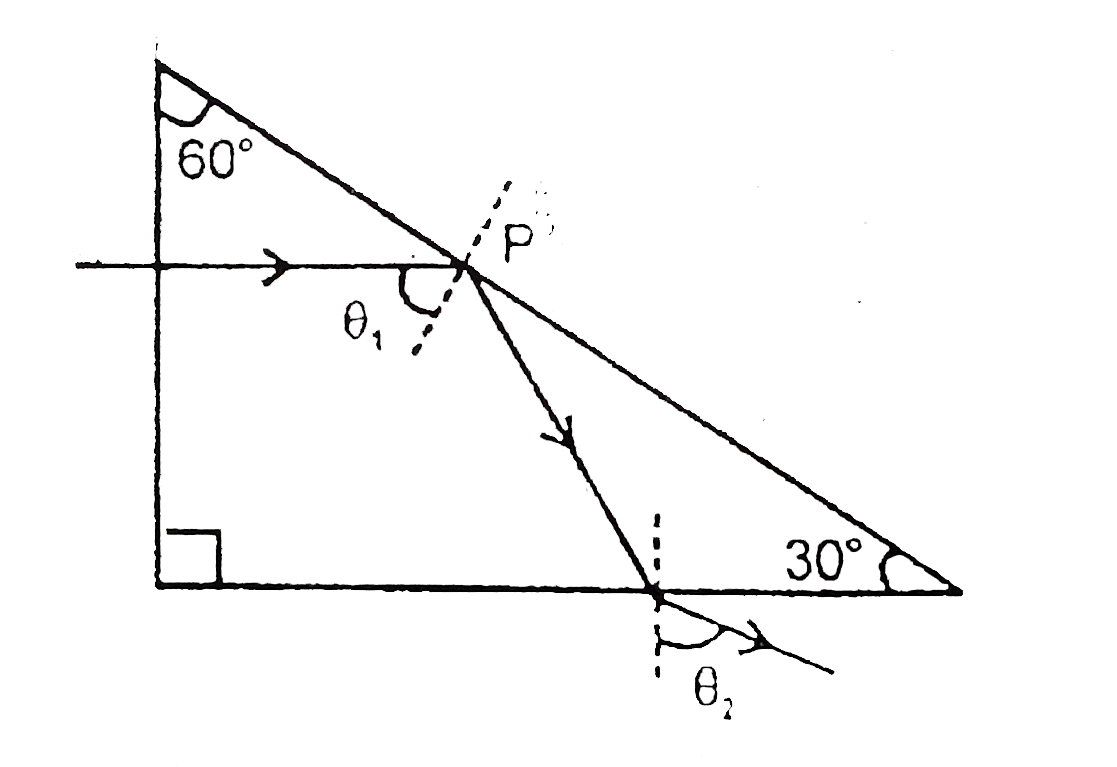A ray of light is incident normally on one face of an equilateral prism of refractive index 1.5. The angle of deviation is: (Given sin−1.23=42∘)
30∘
45∘
60∘
75∘
The correct Answer is:C
To find the angle of deviation for a ray of light incident normally on an equilateral prism with a refractive index of 1.5, we can follow these steps:
Step 1: Identify the critical angle
The critical angle c can be calculated using the formula:
sinc=1μ
where μ is the refractive index of the prism. Given μ=1.5:
sinc=11.5=23
Step 2: Calculate the critical angle
Using the inverse sine function:
c=sin−1(23)
From the problem, we know that sin−1(23)=42∘. Thus, the critical angle c=42∘.
Step 3: Analyze the prism
An equilateral prism has angles of 60∘. When a ray of light is incident normally on one face of the prism, the angle of incidence i is 90∘.
Step 4: Determine the angle of refraction at the first face
Using Snell's law:
n1sini=n2sinr
Here, n1=1 (air), i=90∘, and n2=1.5. Thus:
1⋅sin(90∘)=1.5⋅sinr
This simplifies to:
1=1.5⋅sinr⟹sinr=11.5=23
So, r=42∘.
Step 5: Calculate the angle of incidence at the second face
At the second face of the prism, the angle of incidence i2 is given by:
i2=60∘−r=60∘−42∘=18∘
Step 6: Determine the angle of refraction at the second face
Using Snell's law again:
1.5⋅sin(18∘)=1⋅sinr′
Calculating sin(18∘):
sin(18∘)≈0.309
Thus:
1.5⋅0.309=sinr′⟹sinr′≈0.464⟹r′≈27.7∘
Step 7: Calculate the angle of deviation
The angle of deviation δ is given by:
δ=i−r′=60∘+60∘−180∘=60∘
Conclusion
Thus, the angle of deviation δ is:
δ=60∘
The critical angle c can be calculated using the formula:
sinc=1μ
where μ is the refractive index of the prism. Given μ=1.5:
sinc=11.5=23
Using the inverse sine function:
c=sin−1(23)
From the problem, we know that sin−1(23)=42∘. Thus, the critical angle c=42∘.
An equilateral prism has angles of 60∘. When a ray of light is incident normally on one face of the prism, the angle of incidence i is 90∘.
Using Snell's law:
n1sini=n2sinr
Here, n1=1 (air), i=90∘, and n2=1.5. Thus:
1⋅sin(90∘)=1.5⋅sinr
This simplifies to:
1=1.5⋅sinr⟹sinr=11.5=23
So, r=42∘.
At the second face of the prism, the angle of incidence i2 is given by:
i2=60∘−r=60∘−42∘=18∘
Using Snell's law again:
1.5⋅sin(18∘)=1⋅sinr′
Calculating sin(18∘):
sin(18∘)≈0.309
Thus:
1.5⋅0.309=sinr′⟹sinr′≈0.464⟹r′≈27.7∘
The angle of deviation δ is given by:
δ=i−r′=60∘+60∘−180∘=60∘
Thus, the angle of deviation δ is:
δ=60∘
Similar Questions
A ray of light suffers a minimum deviation when incident on equilateral prism of refractive index √2 The angle of deviation is
View SolutionWhen a ray of light is incident normally on one refracting surface of an equilateral prism (Refractive index of the material of the prism =1.5
View SolutionWhen a ray of light is incident normally on one refracting surface of an equilateral prism (Refractive index of the material of the prism =1.5)
View SolutionA light ray is normally incident onone face of equilateral glass prism of refractive index √2. The deviation of light ray is
View SolutionA ray of light is incident normally on one of the faces of a prism of apex angle 30 degree and refractive index √2. The angle of deviation of the ray in degrees is
View SolutionA ray of light is incident normally normallyh on one of the faces of a prism of apex angle 30∘ and refractive index √2. The angle of deviation of the ray is ________________ degrees.
View Solution
A ray of light is incident normally on one face of a prism as shown in figure. The refractive index of the material of the prism is 53 and the prism is immersed in water of refractive index 43, then
View SolutionA ray of light is incident normally on one face of 30∘−60∘−90∘ prism of refractive index 5/3 immersed in water of refractive index 4/3 as shown in figure .
_E01_076_Q01.png)
View SolutionA ray EF of monochromatic light is incident on the refracting surface AB of a regular glass prism ( refractive index=1.5) at angle of incidence i=55∘ (Figure). If it emerges the adjacent face AC, calculate the angle of emergence .e..
View SolutionA beam of monochromatic light is incident at i=50∘ on one face of an equilateral prism, the angle of emergence is 40∘, then the angle of minimum deviation is :
View Solution
